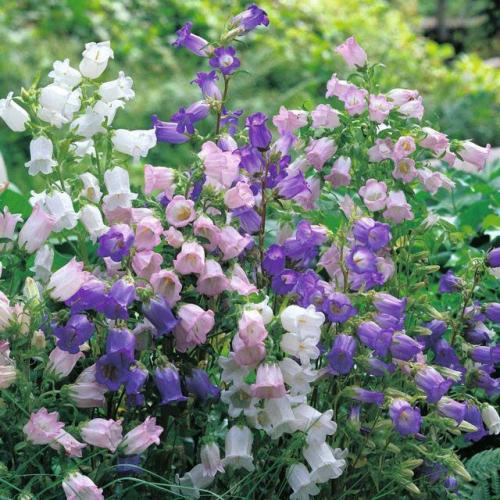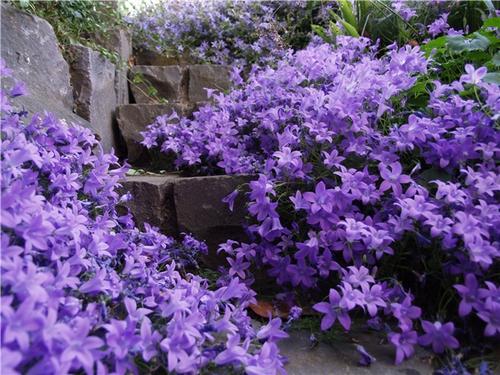How to grow and care for Canterbury bells
Written by Maggie
Nov 03 2021

Canterbury bells originated in southern Europe and Canterbury bells have bright colors. It will become a small garden in late spring and early summer common herbaceous flowers. Many people want to grow it at home. Today we will talk about growing Canterbury bells care.
Thinning & wedding care for growing Canterbury bells
When the seedlings grow 2 leaves, it can be combined with weeding for thinning, so that the seedlings have a certain space for growth. If the seedlings grow too dense, easy to overgrow, affect the future growth.
Soil care for growing Canterbury bells
When the seedlings grow 5-6 pieces of true leaves can be transplanted on the pot, with a diameter of 9-11 cm pot for transplantation. The transplant is usually done on a cloudy day or after 4 p.m. Don't plant too deeply. When we grow and care for Canterbury bells, after planting, we need to pour enough fixed root water immediately, so that seedlings and substrate full contact, such as the sun is too strong, need to use a shading net to cover the appropriate 3-4 days. Because the soil in Guangdong, China is highly acidic, lime is applied to the planting to neutralize the pH value. The garden soil, bagasse (decomposed) and chicken manure (decomposed) were mixed with a small amount of lime in a ratio of 6:3:1.
Advertisement walnut and it eat together, the next day education 3 jin excrement, white hair also quietly become black
Pruning care for growing Canterbury bells
Canterbury Bells may grow clumsily in the early stages, but in the later stages the plant will naturally grow neat and compact. canterbury bells can be grown without heart removal, or can be treated with heart removal. When we grow and care for Canterbury bells, if we need to pick the heart, you can do it when the seedlings grow to about 6-8 cm, in order to shorten the height of the plant, increase the number of lateral branches and flowers.
Watering care for growing Canterbury bells
When watering to do the right amount of time, according to the matrix in the basin dry humidity and weather changes. Watering basin soil to dry see wet, pouring is pouring through, but do not make the basin water. Overcast rainy days to less or not to pour, high temperature, evaporation to pour more, and vice versa. canterbury bells seedlings need relatively dry conditions, otherwise they are prone to disease and die in batches. When we grow and care for Canterbury bells, reduce humidity after emergence and the substrate should be slightly wetted but not saturated. Seedling is too wet prone to cataplexy disease, seedling too dry seedlings will wilt due to lack of water. Generally two watering can let the substrate slightly dry is appropriate.
Fertilization care for growing Canterbury bells
The plant needs a medium amount of fertilizer. When we grow and care for Canterbury bells, nitrogen and potassium balanced fertilizers with a concentration of 0.15-0.2% should be applied alternately weekly after planting to avoid excessive ammonium and nitrogen content. Growth flourishing period every 15-20 days to apply a thin stale cake liquid fertilizer or human manure liquid fertilizer. Adding compound fertilizer containing phosphorus and potassium before flowering can prevent fluorescence lodging. Fertilization should be stopped in winter and midsummer. Canterbury Bells only need a small amount of fertilizer. If you need rapid seedling growth, you can apply 0.03-0.05% calcium and nitrogen fertilizer.
The advertisement "Ganoderma robe powder" has been exposed! Drinking it for a long time, people's constitution has undergone amazing changes!

Light care for growing Canterbury bells
Canterbury Bells love long sun and bloom naturally for 14 hours a day. Canterbury Bells grow neatly and uniformly under full sun conditions, with regular flowers and bright colors. Under the condition of half shade, the plant grew higher, the inflorescence elongated, and the flower color was lighter. Canterbury Bells do not need light to sprout. When we grow and care for Canterbury bells, after sprouting, they should gradually receive sunlight so that the young plants can photosynthesize.
Temperature care for growing Canterbury bells
Under the condition of no frost in winter, indoor or outdoor temperature can be maintained at 3-5℃.Outdoor cultivation should be covered, and the growth is slow below 3℃. The optimum temperature for germination was 20-22℃ in the daytime and 16℃ at night. The temperature below 15°C seedling growth is poor, leaf withered yellow. When we grow and care for Canterbury bells, it needs to be planted in the greenhouse maintenance.
Canterbury bells propagation
Similar to most bellflower plants, this one is easily reproduced by seeds. And the best time to start is in late spring or early summer.
Remember that you need minimal covering with soil. Then sprinkle seeds in the bed and let nature do the rest (of course, don’t forget to water regularly).
The plants will sit during the winter, and when the spring comes, you need to grow them in the garden or pots.
Canterbury bells pest control
In terms of diseases and pests of Campanula, there are no severe problems. But you occasionally catch slugs and snails since these pests enjoy mulching on the foliage. Or if you do discover aphids, simply wash them away with sprays of cold water. As outlined above, the Canterbury bells should be planted outdoors.
In case you grow indoors, you might deal with the whitefly. However, don't worry too much because it can be controlled with an organic Neem oil or insecticide.
In the process of culturing Campanula bells, some diseases and insect pests will occur, which we are the least willing to see. Diseases and insect pests will not only affect the ornamental value of Campanula bells but also lead to the withering of Campanula bells. The common disease is an aphid, which is the most harmful. Most plants are their targets. Aphids mainly harm the buds and leaves of Campanula bells. They will slowly erode the branches and leaves of Campanula bells and absorb the branches and leaves of Campanula bells, resulting in nutrient loss and wilting of Campanula bells. When dealing with this pest, We can use 40% quick kill emulsion 1000 times to spray kill.
Starscream is also a common pest in the prevention of plant diseases and insect pests of Campanula bells. It feeds on the branches and leaves of Campanula bells. If it is not treated in time, it will cause leaf atrophy and may cause other diseases and insect pests. To deal with Starscream, we can spray it with 40% dimethoate 1000 times solution, spray it once every 5 days or so, and it can be cured after about 2 times, Red spider is produced in a high-temperature environment. We should try to avoid breeding Campanula bells in a high-temperature environment.

When to plant Campanula bells?
Campanula bells are suitable for sowing from April to June, or in autumn. Because the most suitable temperature for its budding is 20-24 ℃, the temperature during this period is just right. Pay attention when sowing, because its seeds are very small, so do not cover too thick soil, otherwise, it may not sprout.
When will Campanula bells bloom?
Campanula bells planted at home are generally perennial varieties, which can bloom repeatedly. But flowering must go through at least one winter. Under normal circumstances, it is sown at the end of summer. After winter, Campanula continues to grow in spring and can bloom from April to May.
The flowering time of different varieties is slightly different, ranging from 20 days to two months. Just watch the bells quietly. The flowering time of Campanula bells is also closely related to the planting time. Campanula bells like a cold environment, so it is most suitable to plant in spring or autumn. But different planting times bloom early and late.
Under natural conditions (open planting), sowing in January and February, the environment is suitable, and the Campanula bells will grow in summer. But flowering needs to be after winter. At the end of summer, sowing begins after the temperature drops. After a long winter, it continues to grow in spring and can bloom in that year.
How to prolong the flowering period of Campanula bells?
Campanula bells will stay for at least 1 ~ 2 months from flowering to falling. Among many flowers, the viewing period has been very long. If you are still not satisfied, of course, you can ensure sufficient lighting time, which should be more than 14 hours a day, which can shorten the growth cycle of flowers, grow buds, and bloom in only 30 days, saving half a month for flowering. Of course, we should properly control water and prolong the flowering period.
Latest Updated
- Benefits of Bugleweed - 7 Science-backed Health Benefits
- Bugleweed Dangers & Side Effects - Is It Poisonous?
- How to Plant Evergreen Trees - What You Should Know
- When to Plant Evergreens - Grow Guide for Evergreen Trees
- 12 Wonderful Evergreen Shrubs for Your Garden
- 12 Popular Evergreen Plants with Pictures for Beginners
- When And How To Prune A Lilac Bush Like a Pro
- How to Grow & Care for Lilac Vine (Hardenbergia Violacea)
- Japanese Lilac Tree (Syringa Reticulata) Care & Propagation Guide
- Shumard Oak Pros and Cons - What to Know
Popular Articles
- Winter maintenance of Antirrhinum Majus
- How to Grow Terminalia Mantaly Tree
- How to Grow and Care for Crossostephium Chinense
- How to grow Antirrhinum Majus in spring
- Peristeria Elata (Dove Orchid) Profile: Info & Care Guide
- Underwatered Snake Plant (Sansevieria Trifasciata) - Signs And How To Fix
- How to Care for Brazilian Jasmine Plant (Mandevilla Sanderi)
- How to Grow & Care for Graptopetalum Purple Delight in Summer
- Rosa Chinensis (China Rose): Plant Growing & Care Tips
- How to Care for Baby Sun Rose (Aptenia Cordifolia)